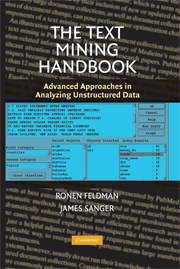Book contents
- Frontmatter
- Contents
- Preface
- I Introduction to Text Mining
- II Core Text Mining Operations
- III Text Mining Preprocessing Techniques
- IV Categorization
- V Clustering
- VI Information Extraction
- VII Probabilistic Models for Information Extraction
- VIII Preprocessing Applications Using Probabilistic and Hybrid Approaches
- IX Presentation-Layer Considerations for Browsing and Query Refinement
- X Visualization Approaches
- XI Link Analysis
- XII Text Mining Applications
- Appendix A DIAL: A Dedicated Information Extraction Language for Text Mining
- Bibliography
- Index
X - Visualization Approaches
Published online by Cambridge University Press: 08 August 2009
- Frontmatter
- Contents
- Preface
- I Introduction to Text Mining
- II Core Text Mining Operations
- III Text Mining Preprocessing Techniques
- IV Categorization
- V Clustering
- VI Information Extraction
- VII Probabilistic Models for Information Extraction
- VIII Preprocessing Applications Using Probabilistic and Hybrid Approaches
- IX Presentation-Layer Considerations for Browsing and Query Refinement
- X Visualization Approaches
- XI Link Analysis
- XII Text Mining Applications
- Appendix A DIAL: A Dedicated Information Extraction Language for Text Mining
- Bibliography
- Index
Summary
INTRODUCTION
Human-centric text mining emphasizes the centrality of user interactivity to the knowledge discovery process. As a consequence, text mining systems need to provide users with a range of tools for interacting with data. For a wide array of tasks, these tools often rely on very simple graphical approaches such as pick lists, drop-down boxes, and radio boxes that have become typical in many generic software applications to support query construction and the basic browsing of potentially interesting patterns.
In large document collections, however, problems of pattern and feature overabundance have led the designers of text mining systems to move toward the creation of more sophisticated visualization approaches to facilitate user interactivity. Indeed, in document collections of even relatively modest size, tens of thousands of identified concepts and thousands of interesting associations can make browsing with simple visual mechanisms such as pick lists all but unworkable. More sophisticated visualization approaches incorporate graphical tools that rely on advances in many different areas of computer and behavioral science research to promote easier and more intensive and iterative exploration of patterns in textual data.
Many of the more mundane activities that allow a user of a text mining system to engage in rudimentary data exploration are supported by a graphic user interface that serves as the type of basic viewer or browser discussed in Chapter VII. A typical basic browsing interface can be seen in Figure X.1.
- Type
- Chapter
- Information
- The Text Mining HandbookAdvanced Approaches in Analyzing Unstructured Data, pp. 189 - 241Publisher: Cambridge University PressPrint publication year: 2006
- 3
- Cited by



